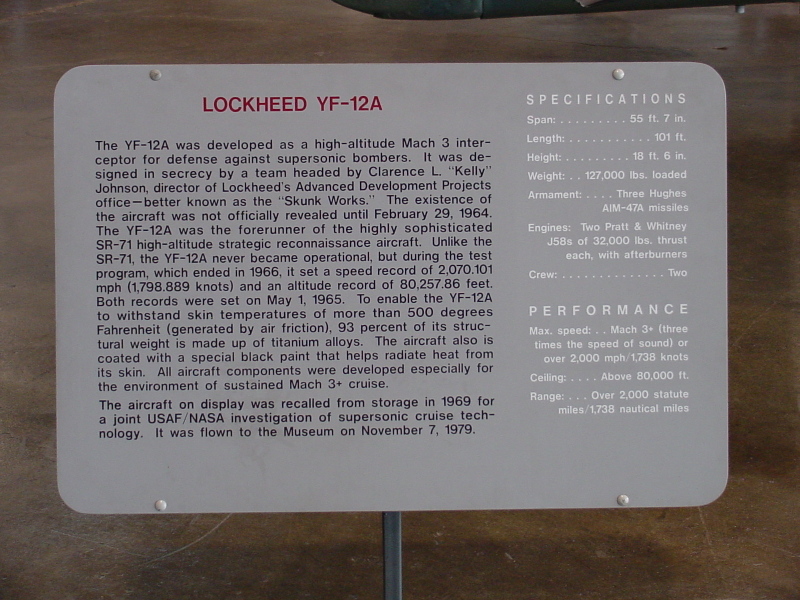| Prev |
heroicrelics.org Air Force Museum Site Index YF-12A Gallery |
Next |
dsc04444.jpg
The sign accompanying the plane. It reads
Lockheed YF-12A
The YF-12A was developed as a high-altitude Mach 3 interceptor for defense against supersonic bombers. It was designed in secrecy by a team headed by Clarence L. "Kelly" Johnson, director of Lockheed's Advanced Development Projects office - better known as the "Skunk Works." The existence of the aircraft was not officially revealed until February 29, 1964. The YF-12A was the forerunner of the highly sophisticated SR-71 high-altitude strategic reconnaissance aircraft. Unlike the SR-71, the YF-12A never became operational, but during the test program, which ended in 1966, it set a speed record of 2,070.101 mph (1,798.889 knots) and an altitude record of 80,257.86 feet. Both records were set on May 1, 1965. To enable the YF-12A to withstand skin temperatures of more than 500 degrees Fahrenheit (generated by air friction), 93 percent of its structural weight is made up of titanium alloys. The aircraft also is coated with a special black paint that helps radiate heat from its skin. All aircraft components were developed especially for the environment of sustained Mach 3+ cruise.
The aircraft on display was recalled from storage in 1969 for a joint USAF/NASA investigation of supersonic cruise technology. It was flown to the Museum on November 7, 1979.
Specifications Span: 55 ft. 7 in. Length: 101 ft. Height: 18 ft. 6 in. Weight: 127,000 lbs. loaded Armament: Three Hughes AIM-47A missiles Engines: Two Pratt & Whitney J58s of 32,000 lbs. thrust each, with afterburners Crew: Two
Performance Max. Speed: Mach 3+ (three times the speed of sound) or over 2,000 mph/1,738 knots Ceiling: Above 80,000 ft Range: Over 2,000 statute miles/1,738 nautical miles

| Time picture taken | Fri Oct 31 11:15:34 2003 |
| Location picture taken | Research and Development/Flight Test Gallery Air Force Museum Dayton, OH |
| Prev | YF-12A Gallery | Next |